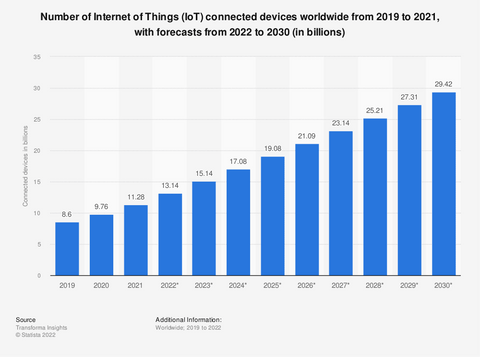The Role of IoT in Remote Work and the Digital World - GroWrk
 Mara Quintanilla
Mara Quintanilla
Appliances interconnect inside your home network, gadgets that capture and analyze biometric data, and cars that sync to our phones. Hyperconnection is as attainable as ever and will soon impact the workplace. The role of the Internet of Things, also known as IoT, in remote work and the digital world, is just starting to make waves.
Industries that initially found it hard to adapt to remote work due to their nature can automate processes thanks to IoT technology. This way, more and more companies can benefit from a work-from-home arrangement.
IoT technologies show no sign of slowing down. Gartner projected for 2022 that the IoT endpoint electronics and communications market would reach $21.3 billion. This represents a 22% increase from 2021’s forecast of $17.5 billion.
The Internet of Things has already tremendously impacted our daily lives. Still, it’s set to become an essential tool for helping the digital workforce by connecting devices and technology to provide solutions that improve efficiency, productivity, and profitability.
By incorporating IoT technology into the workplace, companies can give their employees more freedom and flexibility to complete tasks remotely. Let’s look closely at how IoT impacts remote work and the digital world.
How Does IoT Impact the Remote Working and Digital Workforce

Oracle defines the Internet of Things (IoT) as “the network of physical objects embedded with sensors, software, and other technologies to connect and exchange data with other devices and systems over the Internet.”
The key to understanding IoT is that there is a data transfer among devices connected over a network. IoT works as long as objects are connected and share information. Such items can be ordinary household appliances to industrial and manufacturing tools.
So how can IoT add to the digital transformation already in place thanks to remote work? It’s all in the data that connected devices are aggregating and analyzing.
The Internet of Things (IoT) is transforming how we live, work, and play. It can bring about significant changes in business models and operations and how people interact with technology in their everyday lives.
The amount of IoT-connected devices around the world keeps growing each year. According to Statista, there will be 19.08 billion IoT-connected devices worldwide by 2025. A constant increase from the 13.14 billion projected for 2022.

Only recently, digital tools have made it possible for employees to work from anywhere in the world. With the increasing popularity of remote working, it’s no surprise that many companies are turning towards IoT solutions, such as smart office equipment, to support this way of working.
Key Role of IoT in Remote Work
The pandemic significantly impacted working habits around the world. Remote work became the norm for most knowledge workers as companies struggled to set up and organize strategies to keep their newly distributed teams productive.
And remote work shows no signs of going away. Time reports that as of December 2022, almost 30% of paid workdays happen in a distributed arrangement. The magazine also cites that remote work has expanded six-fold only in the United States since the start of the pandemic and has expanded worldwide for college-educated workers.
As a result, the demand for products, services, and technologies that support communication and collaboration at a distance has increased. That’s precisely where IoT technology has plenty to offer.
With the data collected from connected devices, businesses can tackle challenges with real-time insight into issues or malfunctions. This information can help companies identify ways to reduce waste, improve operational processes, and maximize efficiency.
For example, companies can track their assets and have real-time and specific data on the condition of a particular product in the supply chain. Information can be as precise as the temperature, light exposure, and position inside a container.
In the manufacturing industry, sensors connected to machines via cloud software can give periodic reports on their condition, allowing technicians to monitor the equipment from a distance. It can also help to identify when a machine needs repair and signal to the person in charge that maintenance is necessary.
IoT technologies can aid medical staff in providing virtual care practices in the health industry. For example, blood and pressure monitoring devices can signal to health workers when a patient needs a diagnosis without patients having to be physically present in a hospital.
In terms of security, IoT can help security teams to monitor buildings through sensors and cameras. This way, security workers can manage facilities remotely, knowing that those devices will single out suspicious behavior and alert them to take action.
However, when knowledge workers use IoT technologies at home, companies must follow a cybersecurity checklist and comply with IT policies. Because IoT operates with interconnected devices, remote workers can be vulnerable to hacker attacks since home networks tend to be less secure than those in the office.
Following an IT onboarding checklist can prevent unwanted attacks and instruct remote workers on properly operating company equipment.
The Future of Remote Work and IoT

The possibilities for IoT in business are nearly endless. The technology can streamline processes, reduce costs, and improve communication—from the comfort of your home office or favorite coffee shop.
As more businesses embrace remote work, digital technologies like AI, voice recognition software, and video chat services become more common with mobile devices. The internet of things will become even more indispensable as a tool for increasing remote work productivity.
The Internet of Things (IoT) is a significant driver for remote work and will continue to play an essential role in connecting remote workers now and in the future. It can connect devices, collect data, and manage operations on an unprecedented scale. This will create new business opportunities to improve efficiency, productivity, customer service, and profitability.
As more companies adopt IoT technology, they will be able to monitor their entire supply chain from end to end through real-time data collection and analysis. This could look like not sending employees out into the field to conduct audits or inspections — everything can be done remotely from a computer terminal.
Final Thoughts
The Internet of Things is changing how we do business, interact with each other and live our lives. It has the potential to improve everything from how we shop for groceries to how quickly a doctor can diagnose your disease.
By connecting everything from our clothes to our cars and homes, the Internet of Things will make it easier to access information and communicate with others worldwide.
Companies also benefit from this technology —it gives them the ability to quickly and easily collect data on their customers and employees. This helps them improve products and services and manage their business more efficiently.
Remote work also profits from adopting IoT because it simplifies processes and allows for distributed collaboration. Allowing people to enjoy the proven benefits of a distributed workforce thanks to new ways of connecting and interacting is the future of work.
If you want to be a part of the global digitalization process, give us a shout. At GroWrk, we provide IT asset management for teams distributed across the globe. Our platform lets you seamlessly set up and support your remote workers. Request a demo today to stay ahead.
FAQs about the role of IoT and remote work
What is IoT?
The Internet of Things (IoT) is the interconnection of devices or things through an internet network. Most importantly, it enables these devices to collect and exchange data.
How does IoT work?
IoT covers a broad range of technologies, from simple sensors to more complex systems that can communicate with each other. For example, IoT is having a smart thermostat in your home that adjusts the temperature according to your preferences when you enter the room.
How does IoT benefit remote workers?
IoT technology simplifies processes and automates tasks that would otherwise require a person to be present at a particular worksite. Devices that can sense equipment failure or detect suspicious behavior through cameras allow workers to do their work off-site. Such devices that alert a person in charge or automatically set protocols into action are revolutionizing work across industries.






